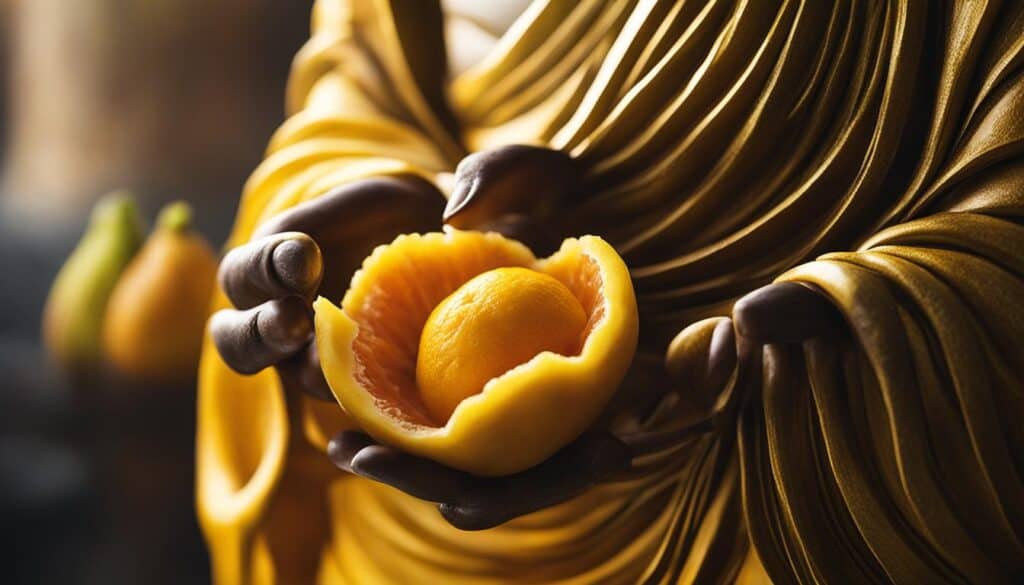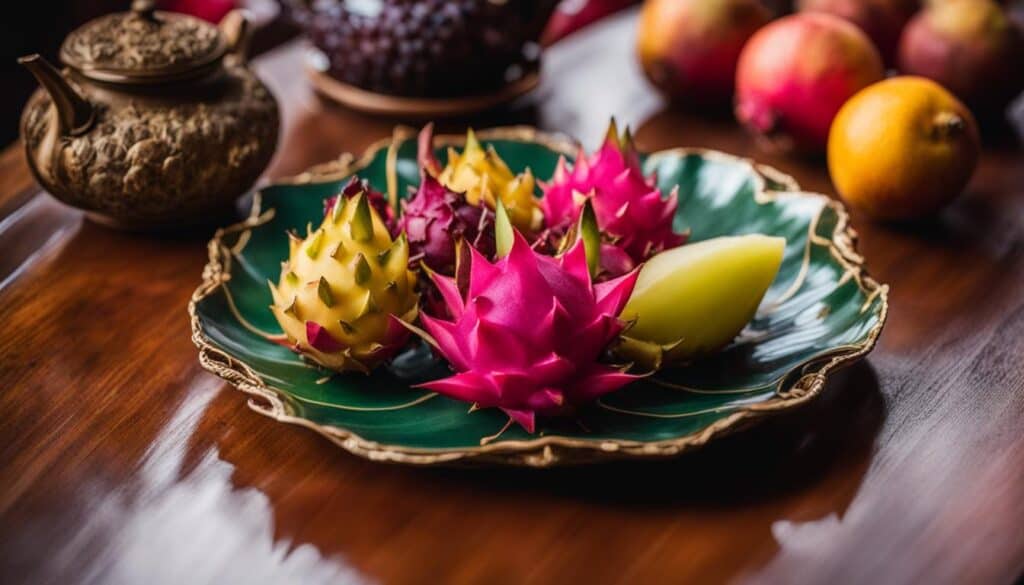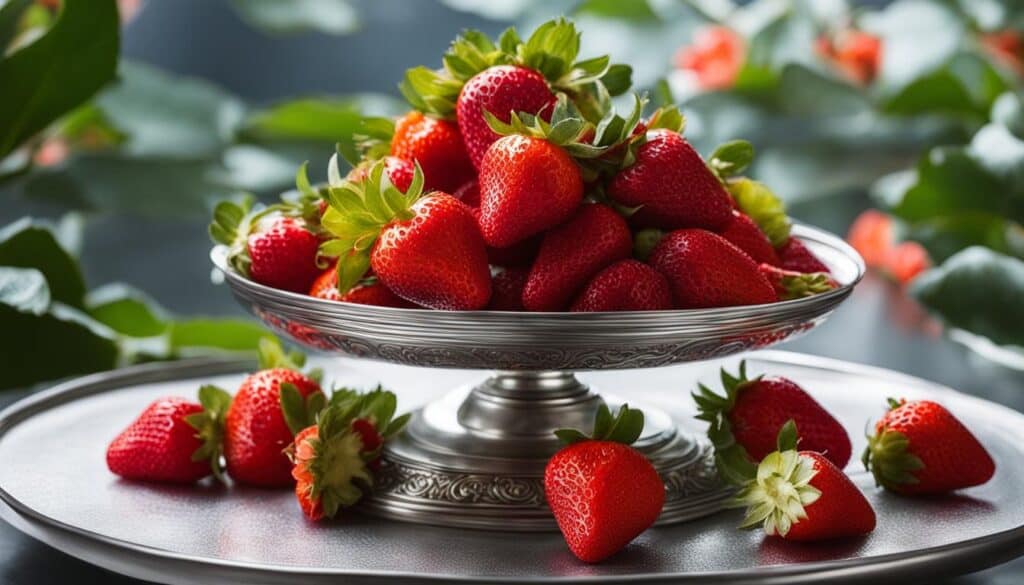If you want to learn about different kinds of fruit in Chinese, you have come to the right place. In this guide, we will explore the fascinating realm of fruit in Chinese, including the names, translations, and traditions associated with various fruits. Whether you are interested in learning how to say fruit in Chinese or want to expand your Chinese vocabulary related to fruit, this guide will be a friendly and inviting resource for you.
Key Takeaways:
- Fruit in Chinese: Discover the names and translations of various fruits in the Chinese language.
- Chinese Fruit Vocabulary: Expand your knowledge of fruit-related words and phrases in Mandarin.
- Learning Fruit in Chinese: Tips and resources to help you learn how to say fruit in Chinese and improve your language skills.
- Chinese Names for Fruit: Explore the cultural significance and traditions associated with different fruits in Chinese culture.
- Fruit Translation in Chinese: Find translations of fruit names in Chinese characters (Hanzi) and their pronunciation (Pinyin).
The Most Common Fruits in Chinese
In this section, we will introduce you to the top 20 most common fruits in Chinese. Learning these fruits is a great way to expand your Chinese vocabulary and enhance your language skills. To help you with memorization, we recommend using fruit flashcards. Flashcards are a fun and interactive tool that allows you to practice and reinforce your knowledge of fruit names in Chinese.
Here are some examples of the most common fruits in Chinese:
| Fruit | Chinese Translation |
|---|---|
| Apple | 苹果 (píng guǒ) |
| Banana | 香蕉 (xiāng jiāo) |
| Orange | 橙子 (chéng zi) |
| Watermelon | 西瓜 (xī guā) |
Remember to practice regularly with your fruit flashcards to reinforce your knowledge and improve your pronunciation. Learning fruit names in Chinese will not only help you communicate more effectively but also deepen your understanding of Chinese culture and cuisine.
A Long List of Fruits in Chinese
In this section, we will provide you with a long list of fruit in Chinese. This comprehensive list includes the translation of fruit names in Chinese characters (Hanzi) and their pronunciation (Pinyin).
| Fruit Name in Chinese | Translation | Pinyin |
|---|---|---|
| 苹果 | Apple | Píngguǒ |
| 香蕉 | Banana | Xiāngjiāo |
| 橙子 | Orange | Chéngzi |
| 草莓 | Strawberry | Cǎoméi |
| 葡萄 | Grape | Pútáo |
| 柠檬 | Lemon | Níngméng |
| 桃子 | Peach | Táozǐ |
| 梨子 | Pear | Lízi |
This is just a small sample of the many fruit names in Chinese. Use this list to expand your vocabulary and knowledge of Chinese fruit names.
Whether you’re learning Mandarin, traveling to China, or simply interested in Chinese culture, knowing the names of fruits in Chinese can be both practical and fun. Explore the rich variety of fruit options available in Chinese cuisine and impress your friends with your newfound knowledge.
Strange Chinese Fruits
China is a land of diverse and exotic fruits that are not commonly found in other parts of the world. These unique fruits are not only visually fascinating but also offer distinctive flavors and textures. Let’s take a closer look at some of the strange Chinese fruits that have captivated both locals and foreigners alike.
One such fruit is the Dragon Fruit, also known as Pitaya. With its vibrant pink or yellow skin and succulent white or pink flesh dotted with tiny black seeds, the Dragon Fruit is a true tropical delight. Its refreshing taste is often compared to a blend of kiwi and pear, making it a popular choice in fruit salads and smoothies.
Another intriguing fruit is the Buddha’s Hand, a citrus fruit that resembles a cluster of yellow fingers reaching towards the sky. Its fragrant aroma and unique shape have earned it the name “Fingered Citron” or “Hand of Buddha.” While the Buddha’s Hand is not typically eaten raw, its zest is often used to add a tangy, aromatic flavor to various dishes and beverages.
| Fruit | Appearance | Taste |
|---|---|---|
| Dragon Fruit | Refreshing, sweet, and subtly tangy | |
| Buddha’s Hand |  | Citrusy, fragrant, and tangy |
The Dragon Fruit is a true tropical delight, with its vibrant pink or yellow skin and succulent white or pink flesh dotted with tiny black seeds.
Lastly, we can’t forget the infamous Durian. Known as the “King of Fruits” in Southeast Asia, the Durian is loved by some and despised by others due to its distinctive smell, which has been described as a mix of sweet custard and rotten onions. However, those who can look past the pungent odor are rewarded with a creamy and rich flavor that is truly unique.
These strange Chinese fruits not only offer a sensory adventure but also hold cultural significance. They are often used in traditional Chinese medicine and are believed to have various health benefits. So, the next time you come across one of these exotic fruits, don’t hesitate to give it a try and embark on a culinary journey through the fascinating world of Chinese fruit.
Quiz: Test Your Knowledge of Fruit in Chinese
Ready to put your knowledge to the test? In this section, we have prepared a fun quiz to challenge your understanding of fruit in Chinese. Test your ability to recognize the Chinese names for different fruits and see how well you have grasped the vocabulary.
Take a look at the table below and try to match the fruit with its corresponding Chinese name. Don’t worry if you’re not sure about some of the answers – this quiz is designed to help you learn and improve. Once you’ve made your selections, scroll down to see how well you did!
| Fruit | Chinese Name |
|---|---|
| Apple | 苹果 (píngguǒ) |
| Banana | 香蕉 (xiāngjiāo) |
| Orange | 橙子 (chéngzi) |
| Watermelon | 西瓜 (xīguā) |
| Grapes | 葡萄 (pútáo) |
Remember: the Chinese language uses characters called Hanzi, which have their own pronunciation system called Pinyin.
How did you do? Check your answers below:
- Apple – 苹果 (píngguǒ)
- Banana – 香蕉 (xiāngjiāo)
- Orange – 橙子 (chéngzi)
- Watermelon – 西瓜 (xīguā)
- Grapes – 葡萄 (pútáo)
Now that you’ve tested your knowledge, take this opportunity to review any fruit names that you might have missed. Learning new vocabulary takes practice, so keep studying and soon you’ll be able to confidently identify and say fruit names in Chinese!
Being a Vegan or Vegetarian in China
If you are a vegan or vegetarian living in China, you may wonder about the challenges and opportunities for maintaining your dietary preferences. China’s rich culinary traditions may seem heavily meat-focused, but there are numerous ways to navigate the vegan and vegetarian lifestyle in the country.
One of the key challenges for vegans and vegetarians in China is the prevalence of animal products in many dishes. It’s important to communicate your dietary restrictions clearly when dining out or ordering food. Many Chinese restaurants are familiar with vegetarian cuisine and can accommodate your needs by offering plant-based alternatives.
Fortunately, the popularity of vegan and vegetarian diets is growing in China, leading to an increased availability of plant-based options. Major cities like Beijing, Shanghai, and Guangzhou have vegan-friendly restaurants and cafes that cater to a range of dietary preferences. These establishments offer delicious and creative plant-based dishes, from traditional Chinese cuisine to international favorites.
Quote: “China has a long history of vegetarianism, and it’s deeply rooted in Chinese culture and Buddhist beliefs,” says Li Mei, a Chinese vegan and advocate for plant-based living. “While it may take some effort to find vegan options, with a bit of research and a willingness to explore, you can discover a world of delicious vegan food in China.”
Plant-Based Diet in China
Embracing a plant-based diet in China can provide numerous health benefits. With a focus on fresh vegetables, fruits, tofu, and other plant proteins, this diet can be rich in nutrients and low in saturated fat. Chinese cuisine also offers a wide variety of plant-based ingredients and flavors, making it possible to create diverse and satisfying meals.
Vegan-Friendly Restaurants in China
| Restaurant | Location | Cuisine |
|---|---|---|
| Vege Tiger | Beijing | Chinese, Asian Fusion |
| Pure & Whole | Shanghai | Healthy, Vegetarian |
| Happy Buddha | Guangzhou | Vegan, Vegetarian, Fusion |
These are just a few examples of the many vegan-friendly restaurants available in China. It’s worth exploring local recommendations and online resources to discover more options that suit your taste preferences and dietary needs.
Being a vegan or vegetarian in China may require some planning and awareness, but with the growing availability of plant-based options and a willingness to explore, you can enjoy a delicious and satisfying culinary experience while staying true to your dietary preferences.

Traditional Breakfast in Taiwan
Besides exploring fruit in Chinese, you might be interested in discovering the culinary traditions of other Chinese-speaking regions. In this section, we will take a closer look at the traditional breakfast in Taiwan. From savory soy milk to crispy scallion pancakes, Taiwanese breakfast dishes offer a delightful and flavorful start to the day.
One popular Taiwanese breakfast dish is Dan Bing, a savory pancake filled with egg, scallion, and sometimes topped with a spread of sweet and savory sauces. It’s a simple yet satisfying option that can be found in many local breakfast shops. Another staple is Soy Milk, a nutritious and protein-rich drink made from soaking and grinding soybeans. It can be enjoyed plain or paired with various additions such as fried dough sticks or rice rolls.
No Taiwanese breakfast is complete without Shao Bing, a flaky and crispy sesame flatbread often served with salty or spicy fillings like sliced pork, pickled vegetables, or egg. For those with a sweet tooth, Guo Bao Rou is a must-try. It is a Taiwanese-style sweet and sour pork dish that is crispy, tangy, and absolutely delicious.
Taiwanese Breakfast Dishes
| Traditional Taiwanese Breakfast Dishes | Description |
|---|---|
| Dan Bing | A savory pancake filled with egg and scallion. |
| Soy Milk | A nutritious drink made from soaked and ground soybeans. |
| Shao Bing | A flaky sesame flatbread with various fillings. |
| Guo Bao Rou | Taiwanese-style sweet and sour pork. |
“Taiwanese breakfast is a true reflection of the island’s vibrant food culture. It combines a mix of flavors and textures that can satisfy different cravings in a single meal. Whether you prefer something savory or sweet, there is always a delightful option waiting to be explored.”
Fruit in Japanese Cuisine
While we primarily focus on fruit in Chinese in this guide, it is also interesting to explore the role of fruit in Japanese cuisine. Japan is known for its rich culinary traditions, and fruit plays a significant part in many traditional Japanese dishes. From refreshing melons to delicate persimmons, Japanese fruit adds a touch of sweetness and elegance to the cuisine.
One of the most popular fruits in Japan is the apple. Known for its crisp texture and juicy flavor, Japanese apples are a favorite among locals and visitors alike. Varieties such as Fuji apples and Aomori apples are widely grown and enjoyed throughout the country. Whether eaten on their own or used in desserts, apples are a versatile and delicious ingredient in Japanese cooking.
Another beloved fruit in Japan is the peach. With its vibrant color and succulent flesh, the Japanese peach is highly prized for its sweetness. Varieties like the Yamanashi peach and the Okayama peach are especially popular. Peaches are often used in desserts, like peach jelly or peach mochi, and are also enjoyed fresh during the summer months.
Lastly, mandarin oranges, commonly known as mikan in Japan, are a staple of Japanese fruit culture. These small, easy-to-peel oranges are a popular snack, especially during the winter season. Mandarin oranges are also used in various desserts and beverages, adding a bright citrus flavor. The Satsuma mandarin is one of the most famous varieties of mikan in Japan.
| Fruit | Characteristics | Common Uses |
|---|---|---|
| Apple | Crisp texture, juicy flavor | Eaten fresh, used in desserts |
| Peach | Soft, sweet flesh | Used in desserts, eaten fresh |
| Mandarin Orange | Small, easy-to-peel | Eaten as a snack, used in desserts |
In conclusion, fruit plays an important role in Japanese cuisine, adding flavor, color, and sweetness to a variety of dishes. Whether it’s the crispness of Japanese apples, the sweetness of peaches, or the refreshing taste of mandarin oranges, Japanese fruit offers a delightful experience for the senses. Exploring the different varieties and culinary uses of fruit in Japan can provide a deeper appreciation for the country’s rich gastronomic culture.

One of the most famous luxury fruit brands in Japan is Shizuoka’s Crown Melons. These melons are grown with the utmost care, individually wrapped in protective netting to prevent blemishes, and nurtured for months until they reach peak ripeness. The result is a melon that is perfectly round, with a smooth rind and sweet, juicy flesh. Crown Melons are often given as prestigious gifts and can be found in luxury fruit gift boxes.
Another popular luxury fruit in Japan is the Sun Fuji apple from Nagano. These apples are carefully grown in ideal conditions, resulting in a vibrant red color, crisp texture, and a perfect balance of sweetness and tartness. Sun Fuji apples are often sold individually, showcasing their premium quality and appeal to fruit connoisseurs.
| Japanese Luxury Fruit Brands | Location | Signature Fruit |
|---|---|---|
| Shizuoka’s Crown Melons | Shizuoka | Melons |
| Sun Fuji | Nagano | Apples |
These luxury fruits are not only prized for their taste and appearance but also for the experience they provide. They are often given as gifts for special occasions or enjoyed in high-end fruit parlors where they are carefully prepared and served with reverence. The attention to detail and craftsmanship that goes into growing these luxury fruits is truly remarkable and reflects the Japanese commitment to excellence.
So, if you ever have the opportunity to try luxury fruit in Japan, be prepared to indulge in an unforgettable sensory experience. From the moment you see these beautifully presented fruits to the first bite that bursts with flavor, you’ll understand why they are considered the epitome of fruit perfection.
Conclusion
In conclusion, this guide has provided you with a comprehensive overview of fruit in Chinese. Whether you are a beginner looking to learn the Chinese names for fruit or a language enthusiast wanting to expand your vocabulary, this guide has something for everyone.
We started by introducing the most common fruits in Chinese, giving you a solid foundation to build upon. From there, we explored a long list of fruit names in Chinese, complete with translations and pronunciations to help you master the language.
But it didn’t stop there. We also took a deep dive into the world of strange Chinese fruits, fascinating you with their unique characteristics and cultural significance. And for those following a vegan or vegetarian lifestyle, we provided valuable insights and tips for navigating China’s culinary scene.
So, whether you’re interested in fruit in Chinese for its linguistic value or simply want to explore the rich cultural tapestry surrounding Chinese fruit, we hope this guide has been both informative and enjoyable. Happy learning and tasting!
FAQ
How do you say fruit in Chinese?
The word for fruit in Chinese is “shuǐguǒ” (水果), which literally translates to “water fruit”.
Can you provide a list of the most common fruits in Chinese?
Sure! The most common fruits in Chinese include apple (píngguǒ 苹果), banana (xiāngjiāo 香蕉), orange (chéngzi 橙子), watermelon (xīguā 西瓜), and strawberry (cǎoméi 草莓), to name a few.
How do you say “apple” in Chinese?
In Chinese, “apple” is pronounced as “píngguǒ” (苹果).
What are some strange Chinese fruits?
There are several unique and unusual fruits in Chinese culture, such as Dragon Fruit (lóngzhū guǒ 龙珠果), Buddha’s Hand (fóshǒu 佛手), and Durian (míngxiāng guǒ 冥香果).
Are there vegan-friendly options in China?
Yes, there are vegan-friendly options in China. Many restaurants offer plant-based dishes, and you can also find traditional Chinese dishes that are naturally vegan, such as stir-fried vegetables and tofu dishes.
What is a traditional breakfast in Taiwan?
A traditional breakfast in Taiwan often includes dishes like savory soy milk (dòujiāng 豆浆), scallion pancakes (cōngyóubǐng 葱油饼), and steamed buns (bāozi 包子).
What fruits are commonly used in Japanese cuisine?
Japanese cuisine incorporates a variety of fruits, including apples (ringo 林檎), peaches (momo 桃), and mandarin oranges (mikan みかん).
What are some luxury fruits in Japan?
Japan is known for its premium and luxurious fruit offerings, such as Sun Fuji apples (Taiyō no Fuji 太陽の富士) and Crown Melons (Kuraun meron クラウンメロン), which are carefully cultivated and highly sought after.
Where can I find a comprehensive guide to all fruit in Chinese?
You can find a comprehensive guide to all fruit in Chinese on our website, which lists the translations and pronunciations of various fruits in Chinese characters (Hanzi) and Pinyin.





Leave a Reply